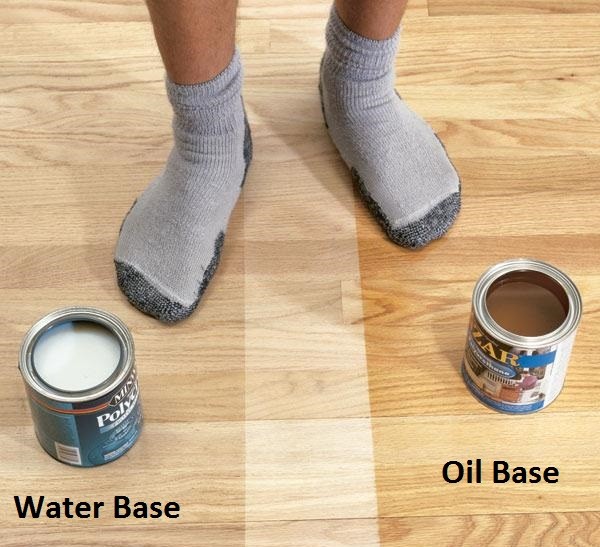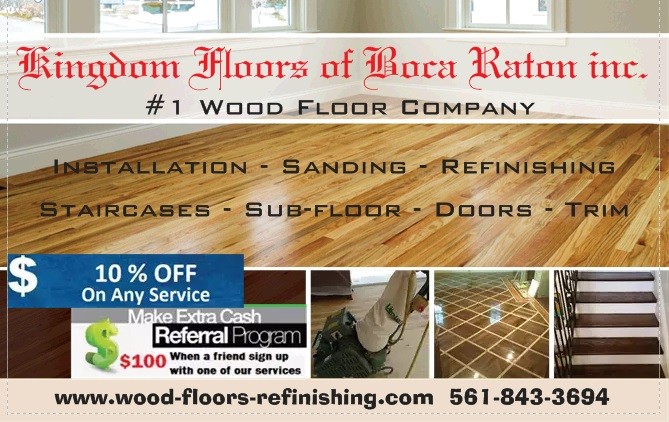#1 Wood Floor Company in Boca Raton, FL
Call us today at: 561-843-3694
Wood Floor Installation, Sanding, Refinishing, Staircases, Sub-Floor, Doors, Trim.
Why Wood Floor ?
Hardwood floors are longer-lasting and can be refinished many times to freshen the look. Some people champion hardwood’s natural beauty. It’s easy to clean and can look new for decades if cared for properly.
Wood it is seen as being “high end” and “luxurious”, because it is a natural material, and its surface is unique to that particular installation. Depending on the type of wood chosen, and how it is finished, hardwood can command a sense of great power, and even prestige, when used in certain locations.
What is the first thing your toes touch in the morning, hardwood or carpet?
Cleanliness: Many people feel that it is impossible to really clean carpet. Stains soak in and settle permanently, and dust and micro bacteria tend to get attracted to, and caught in the fibers of the floor. Hardwood, by contrast, has a smooth, solid surface that can be easily wiped clean. There is no where for dust or dirt to hide making it much easier to maintain than carpet.
Hardwood Flooring: It’s What Buyers WantAccording to HGTV, the top request of home buyers and renters when looking for a home is hardwood flooring. In fact, a study of home buyer preferences by USA Today using data from the National Association of REALTORS® found that 54% of home buyers were willing to pay more for a home with hardwood flooring.
Easy to Maintain is a little more than simple sweeping and vacuuming, always making sure your hardwood floors are protected from moisture and heavy wear which creates scratches. Preventive maintenance like area rugs, floor protectors (on ALL furniture on your hardwood floors), and routine maintenance with proper hardwood floor cleaner should always be exercised (improper products can contribute to additional wear, may VOID your warranty, and cause failure when recoating.
Allergies: The fact that carpet can attract and hold dust and microorganisms can also have an effect on anyone working or living in the space; especially if they suffer from allergies. Every time you walk across the carpet millions of tiny particles can fly into the air. With hardwood, all you have to do is wipe or sweep the surface clean and you can see that it is free of those same potentially harmful particles
Refinished: When a hardwood floor is damaged, either by a stain, or through some sort of physical trauma, it can be refinished to look like new. This involves sanding down the surface past any defects, and then re-applying the stain and or finish products to make the floor look completely revitalized. Depending on the thickness of the material this is something that can be done several times over the life of the floor.
Timeless: Hardwood flooring has been used in homes for hundreds of years, and despite constant shifts in style and trend, it has never stopped being popular. It always matches whatever colors and accessories happen to be in vogue, and can easily handle numerous different decorative choices.
Choose The Finish That You Want


Buyers Checklist
Here are some key questions you need to ask yourself
BEFORE you even think of shopping for a floor.
Answering these will help determine appropriate choices.
This is a formidable task, we admit,
but if you want to do it right,
there’s no alternative.
TIP: Put a long straight piece of metal or wood on the floor and look to see how much of a gap appears underneath it. For floating floors, variations of up to 3/16 of an inch over an eight foot length are generally allowed. If more than that, you’ll have to fill the dips or sand the bumps; this can be a serious and expensive task and usually requires a professional. Always read the installation instructions provided by the manufacturer to determine the tolerances specific to your floor.
If it’s a wood subfloor, you can glue, nail or float your floor over it. In some cases, you may not wish to remove your existing floor because it’s too difficult or expensive. In these cases you may wish to float a floor right over the old floor.
TIP: Remember to consider the clearance under the doors—they may have to be cut down if the clearance is too low. If you have a layer of old hardwood, the greenest and least expensive decision may be to refinish it rather than replace it. Also, refer to Mistake #7 regarding adhesives.
TIP: Moisture meters or calcium chloride tests are very useful in determining moisture content. If your contractor does not have one, they’re available online or sometimes they can be rented.
TIP: Make sure the underlayment is non-toxic and has a very low R-value so it does not block the heat coming through. See mistake #7 for more info.
TIP: If your pet has problems controlling urine, consider a ceramic tile floor or linoleum sheet product. Most wood, bamboo, cork or carpet do not do well when exposed to acidic pet urine.
TIP: If there’s a shipping or warehouse mess up, the retailer won’t pay for your contractor’s time. Therefore, always plan WAY in advance and never schedule a contractor until you have a firm date of delivery and a tracking number.
TIP: Many of our customers test products by putting them into a hot car and waiting outside a few hours. When they go back inside the car, the heat has usually caused some off-gassing to occur and any toxic ingredients are more readily detectable in a small space. MSDS: Reading the Material Safety Data Sheet (MSDS) is not enough because manufacturers don’t always divulge proprietary ingredients or toxic chemicals that amount to less than 1% of the total volume. Manufacturers are only required to disclose “known” hazards of which only 20% have ever been tested for human health. This means 80% of all chemicals are “unknown” as far as their affects on humans are concerned, and the government has a “don’t ask, don’t tell” approach to these chemicals.


